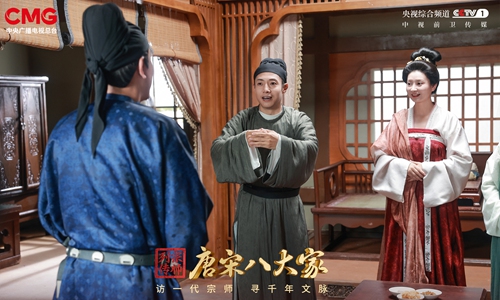New TV show decodes legends of eight ancient masters of Tang and Song dynasties

The China Media Group has recently launched a cultural variety show, Biographies of Masters: the Eight Great Masters of the Tang and the Song Dynasties. The eight great masters come to life across the passage of thousands of years, allowing audiences to explore their profound and dramatic life stories. Through these compelling stories, incisive cultural interpretations, and innovative visual presentations, audiences can delve into the creation of timeless masterpieces and feel the enduring power of Chinese culture.
The term "The Eight Great Masters" is widely recognized in Chinese culture. It encompasses two luminaries from the Tang Dynasty (618-907), Liu Zongyuan and Han Yu, as well as six notable figures from the Song Dynasty (960-1279): Ouyang Xiu, Wang Anshi, Zeng Gong, Su Xun and his sons Su Shi and Su Zhe.This phrase celebrates their unmatched contributions and prominence in the realms of Chinese art and literature.
The core challenge for cultural variety shows is to use the thoughts of ancient people to address the questions faced by people today and to cause ancient stories to resonate with today's social psyche. As the first variety show to focus on "The Eight Great Masters", it needs to present deep thoughts and life wisdom, encompassing a vast range of ideas. Specifically, it involves exploring artifacts, the heart of literature, and the pulse of culture to find answers that connect the past and present.
The primary narrative thread of the show is artifacts. These artifacts contain the cultural codes for the origins as well as the future of Chinese culture, boasting ancient wisdom which may be converted to contemporary enlightenment. For instance, the show starts with the only extant original calligraphy work of Han Yu, Eulogy to Cao'e, from the Eastern Jin (317-420). Rather than analyzing his calligraphy techniques, the show shifts its focus on the two characters at a corner of the work - Tuizhi. Many know Han Yu's courtesy name was Tuizhi, which means take a step back, but few are aware of its story. Han Yu repeatedly failed the imperial examinations, but his wife told him not to lose heart, saying, to achieve great things, one must first take a step back. Han Yu took his wife's advice to heart and eventually became a renowned figure.
This simple wisdom derived from life and valuable experiences gained from adversity carries warmth and spirit beyond the confines of words and time. The show takes the audience through a journey which starts with a single artifact.
How can the words and sentences written in classics resonate with the vivid life of an individual? This is the second aspect the show seeks to explore: the heart of literature. When the heart of literature resonates across ages, thoughts continue to thrive, and culture is passed on. The show not only focuses on showcasing the remarkable achievements of these masters but also how these achievements have influenced history, converse with the present and shape the future.
In addition to their literary prowess, the show also vividly presents the masters' hobbies and interests. The show employs an immersive approach with hosts dressed in costumes staging the life stories of these masters. The show uses a format combining "immersive live-action interpretation, cinematic filming, and XR (extended reality) innovative presentation." Leveraging the visual, tangible, and immersive characteristics of mass media, the show returns to dramatic traditions, narrating stories of these figures. Meanwhile, through technology like XR, the lives of ancient figures leap to the modern screen.
The show also features a screen that marks the "significant events in the lives of the main figure" in each episode. When the hosts touch the screen, a great master is transformed back into an ordinary person undergoing trials and making choices, with key moments of their life slowly unfolding in the XR space.
Whenever we look back at history, we always find familiar figures in the continuum of culture, their writings passed down through generations, their stories known to all households. The show elevates this "familiarity" to a level of thoughtful depiction, allowing historical figures to be understood and learned from. By focusing on the broader picture and attending to the finer details, the show marks a shining coordinate on the radiant star map of Chinese culture for these great masters, at the intersection of traditional culture and modern spirit.
The author is deputy director of the TV Research Center at Peking University.